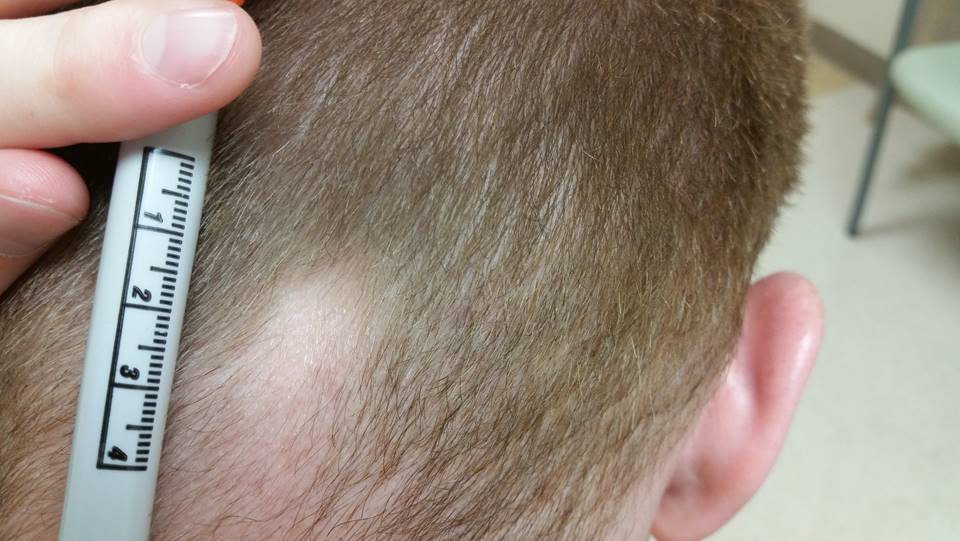Peer Reviewed
Occipital Hair Loss in a 26-Year-Old Man
AFFILIATIONS:
1Intern Physician, Walter Reed National Military Medical Center, Bethesda, MD
2Department of Dermatology at Walter Reed National Military Medical Center, Bethesda, MDCITATION:
Ruda R, Lannan F, Handfield K. Occipital hair loss in a 26-year-old man. Consultant. 2023;63(4):e4. doi:10.25270/con.2022.07.000019Received September 19, 2021. Accepted September 24, 2021. Published online July 29, 2022.
DISCLOSURES:
The authors report no relevant financial relationships.DISCLAIMER:
The views expressed in this article are those of the authors and do not necessarily reflect the official policy or position of the Department of the Navy, the Department of Defense, or the US Government.CORRESPONDENCE:
Rachel Ruda, MD, Walter Reed National Military Medical Center, 8901 Wisconsin Avenue, Bethesda, MD 20889 (rachel.c.ruda.mil@mail.mil)A 26-year-old man with no significant medical history presented to our clinic with an area of hair loss on his posterior scalp (Figure). He reported first noticing the hair loss 4 years prior to presentation and denied any changes to the area or development of new lesions since onset. He denied any associated symptoms, including pruritus or tenderness.
A physical examination was notable for a 2.0 × 1.5 cm oval, slightly depressed, partially hairless patch on the occipital scalp. Trichoscopy demonstrated a normal scalp with vellus hairs scattered throughout the patch.

Figure. Hair loss on the patient’s posterior scalp.
Based on the patient's presentation, what is your diagnosis?
- Alopecia areata
- Temporal triangular alopecia
- Trichotillomania
- Lichen planopilaris
- Discoid lupus erythematosus
Answer and discussion on next page.
1. Trakimas C, Sperling LC, Skelton HG III, Smith KJ, Buker JL. Clinical and histologic findings in temporal triangular alopecia. J Am Acad Dermatol. 1994;31(2):205-209. doi.10.1016/s0190-9622(94)70147-4
2. Willett MC, Sperling LC. Temporal triangular alopecia acquired in adulthood. Cutis. 2017;100(1):E4-E5. https://cdn.mdedge.com/files/s3fs-public/Document/July-2017/ct100001004_e.pdf
3. Yin Li VC, Yesudian PD. Congenital triangular alopecia. Int J Trichology. 2015;7(2):48-53. doi.10.4103/0974-7753.160089
4. Yamazaki M, Irisawa R, Tsuboi R. Temporal triangular alopecia and a review of 52 past cases. J Dermatol. 2010;37(4):360-362. doi.10.1111/j.1346-8138.2010.00817.x
5. Inui S, Nakajima T, Itami S. Temporal triangular alopecia: trichoscopic diagnosis. J Dermatol. 2012;39(6):572-574. doi.10.1111/j.1346-8138.2011.01348.x
6. Sperling LC, Sinclair RD, El Shabrawi-Caelen, L. Chapter 69: Alopecias. In: Bolognia JL, Schaffer JV, Cerroni L, eds. Dermatology. 4th ed. Elsevier; 2018:1162-1187.
7. Bolduc C, Sperling LC, Shapiro J. Primary cicatricial alopecia: lymphocytic primary cicatricial alopecias, including chronic cutaneous lupus erythematosus, lichen planopilaris, frontal fibrosing alopecia, and Graham-Little syndrome. J Am Acad Dermatol. 2016;75(6):1081-1099. doi.10.1016/j.jaad.2014.09.058



